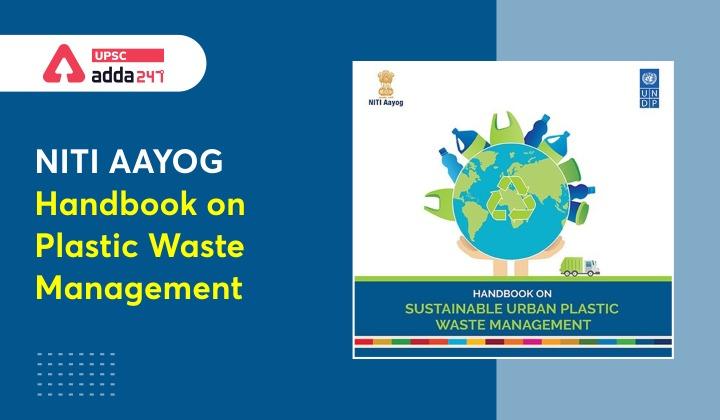Table of Contents
NITI AAYOG handbook on sustainable plastic management: Relevance
- GS 2: Government policies and interventions for development in various sectors and issues arising out of their design and implementation.
NITI AAYOG handbook on sustainable plastic management: Context
- NITI Aayog and UNDP India launched a handbook to promote the sustainable management of plastic waste in the country.
- NITI Aayog has recently launched a report on Reforms in Urban Planning Capacity in India to ramp up urban planning capacity in India.
NITI AAYOG handbook on sustainable plastic management: Key points
- The report has been jointly developed by UNDP India and NITI Aayog, in consultation with eminent experts and leading organizations in the domain of plastic waste.
- Generating mass awareness is the key for achieving sustainable plastic waste management in India.
- The Indore model of spreading mass awareness and explaining importance of plastic waste management methods at household level needs to be adopted by other cities.
- The UNDP handbook covers crucial components for sustainable management of waste including, technical models, recovery facilities, IEC and digitisation, and good governance.
UNESCO State of Education Report 2021
NITI Aayog handbook components for sustainable waste management in India
Component I: Technical model for plastic waste recycling and management
-
- This component is based on an integrated and inclusive approach.
- It involves different stakeholders and their social benefits cover the development of a baseline system of plastic waste management at the city level; systems approach for promoting recycling of plastic waste at the city level, among others.
Component II: Material Recovery Facility – For improved plastic waste management implementation
-
- This component explains the complete functioning of a material recovery facility (MRF), ways to improve waste management beginning from site identification, construction and waste processing mechanisms at the MRF.
Component III: Institutionalization of MRFs in governance bodies
-
- The mainstreaming of waste pickers in the plastic waste management system would result in improved socio-economic conditions for waste pickers and increased recognition in society.
- This requires the institutionalization of various recommended models and waste pickers by ULBs for long-term sustainability.
Component IV: IEC and Digitalization
-
- This component includes the development of knowledge management mechanisms by establishing an in-built adoptive feedback system from different stages of plastic waste value chain.
- It also involves the identification of various technology platforms, or technical service providers, linkages with relevant stakeholders such as bulk waste generators (BWGs), recyclers and waste pickers.
Tamil Nadu Wage Urban Employment Guarantee Scheme for Urban Poor
UNDP handbook objectives
- The models aim to bring sustainable plastic waste management into practice.
- The various systems approach detailed out in the report are aligned with the Swachh Bharat Mission 2.0 and the Plastic Waste Management Rules, 2016 and 2018.
- These models ensure compliance with regulations and improve resource utilization.
- The models not only focus on managing plastic waste but also on social inclusion and protection for waste pickers by improving their socio-economic conditions.




 TSPSC Group 1 Question Paper 2024, Downl...
TSPSC Group 1 Question Paper 2024, Downl...
 TSPSC Group 1 Answer key 2024 Out, Downl...
TSPSC Group 1 Answer key 2024 Out, Downl...
 UPSC Prelims 2024 Question Paper, Downlo...
UPSC Prelims 2024 Question Paper, Downlo...




